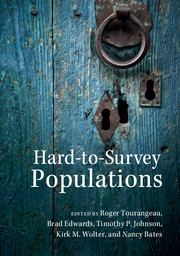Book contents
- Frontmatter
- Dedication
- Contents
- List of figures
- List of tables
- List of boxes
- List of contributors
- Preface
- Part I Introduction
- Part II Conducting surveys in difficult settings
- 6 Disaster research: surveying displaced populations
- 7 Conducting surveys in areas of armed conflict
- 8 Interviewing in disaster-affected areas: lessons learned from post-Katrina surveys of New Orleans residents
- 9 Reaching and enumerating homeless populations
- 10 “Where are our costumes?”: the All Ireland Traveller Health Study – our Geels 2007–2011
- Part III Conducting surveys with special populations
- Part IV Sampling strategies for the hard to survey
- Part V Data collection strategies for the hard to survey
- Index
- References
7 - Conducting surveys in areas of armed conflict
Published online by Cambridge University Press: 05 September 2014
- Frontmatter
- Dedication
- Contents
- List of figures
- List of tables
- List of boxes
- List of contributors
- Preface
- Part I Introduction
- Part II Conducting surveys in difficult settings
- 6 Disaster research: surveying displaced populations
- 7 Conducting surveys in areas of armed conflict
- 8 Interviewing in disaster-affected areas: lessons learned from post-Katrina surveys of New Orleans residents
- 9 Reaching and enumerating homeless populations
- 10 “Where are our costumes?”: the All Ireland Traveller Health Study – our Geels 2007–2011
- Part III Conducting surveys with special populations
- Part IV Sampling strategies for the hard to survey
- Part V Data collection strategies for the hard to survey
- Index
- References
Summary
Introduction
The humanitarian tragedy of large-scale armed conflict continues to be part of human experience leaving a tremendous demographic, social, economic, and health impact on societies. Investigating the impact of such conflicts, assessing the community’s needs, and guiding and evaluating interventions require collecting reliable information on the affected population. Survey research provides tools for collecting such information, but the obstacles to successful survey data collection in these circumstances are substantial. We argue that conducting surveys in armed conflict settings is difficult, but can be done and done well by following a few design and implementation principles. We begin this chapter by summarizing these principles and discuss them further in the remaining sections of the chapter. These principles are derived from the authors’ experiences conducting surveys in such settings and reports from the literature and are based on observational rather than experimental evidence, but reflect the forefront of research on these topics. The first principle is to maintain an adaptive (flexible) approach at all phases of the survey allowing researchers to adjust the study protocols to such volatile circumstances. Second, mixed method approaches can be used to maximize that flexibility and minimize the weaknesses in a survey data collection design by capitalizing on the strengths of supplementary methods. Third, recruitment and training of interviewers require unconventional approaches such as: maintaining political neutrality during recruitment and training, and adding training components on psychological preparation, the art of politically neutral interactions, and handling conversations with respondents about the conflict. The fourth principle is to tailor data collection methods to deal with specific armed conflict challenges. Examples include: tailoring approaches to minimize refusals and noncontact, special efforts to secure interview privacy, and unconventional monitoring. Fifth, data collection in armed conflict settings often raises major ethical considerations that need to be carefully addressed. Overall, most good survey practice in armed conflict settings is no different from good general survey practice. But the challenges associated with these settings demand new mixes of existing approaches and flexibility to address the specific local conditions.
- Type
- Chapter
- Information
- Hard-to-Survey Populations , pp. 134 - 156Publisher: Cambridge University PressPrint publication year: 2014
References
- 9
- Cited by

